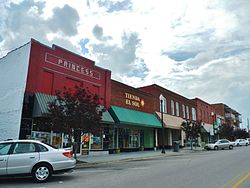Albertville, Alabama
| Albertville, Alabama | |
|---|---|
| City | |

Albertville in 2012.
|
|
 Location in Marshall County and the state of Alabama |
|
| Location in the United States | |
| Coordinates: 34°15′55″N 86°12′40″W / 34.26528°N 86.21111°WCoordinates: 34°15′55″N 86°12′40″W / 34.26528°N 86.21111°W | |
| Country | United States |
| State | Alabama |
| County | Marshall |
| Incorporated | February 18, 1891 |
| Government | |
| • Type | Mayor Council |
| • Mayor | Tracy Honea |
| Area | |
| • Total | 26.1 sq mi (67.5 km2) |
| • Land | 26 sq mi (67.2 km2) |
| • Water | 0.1 sq mi (0.3 km2) |
| Elevation | 1,089 ft (332 m) |
| Population (2013) | |
| • Total | 21,556 |
| • Density | 796.8/sq mi (307.6/km2) |
| Time zone | Central (CST) (UTC-6) |
| • Summer (DST) | CDT (UTC-5) |
| ZIP code | 35950-35951 |
| Area code(s) | 256 |
| FIPS code | 01-00988 |
| GNIS feature ID | 0112970 |
| Website | cityofalbertville.com |
Albertville is a city in Marshall County, Alabama, United States, and is included in the Huntsville-Decatur Combined Statistical Area. As of the 2010 census, the population of the city was 21,160.
The area which today includes Albertville was inhabited by the Cherokee Indians until their removal to Oklahoma in the 1830s. It was, however, near the territory of the Creek nation, and several major trails which afforded communication (or military action) between the two nations crossed the area. It is believed to have been crossed by Spanish explorer Hernando de Soto during his expeditions in 1540.
During the American Civil War, the area around Albertville was the scene of several mid-level clashes between Union and Confederate forces.
The first non-indigenous settlement in what is today Albertville began in the 1850s, and the settlement was named for Thomas A. Albert, an early settler who moved from Georgia and was a town leader until his death in 1876. The city was incorporated in 1891. A post office was established in 1910.
At about 4:10 p.m. on April 24, 1908, the city was virtually wiped out by a tornado that became commonly called "The Great Cyclone," or "The Cyclone of 1908." The storm is believed to have killed 35 people across northeastern Alabama, including 15 in Albertville. Relief was largely delivered by railroad, particularly from the nearby city of Gadsden. Trains from Gadsden transported doctors, nurses, and the Queen City Guards, the Alabama militia company based in Gadsden. The commander of the latter, future Gadsden mayor and Col. R.A. Mitchell, reported in a dispatch to Governor B.B. Comer:
... The destruction of property here is, I think, unprecedented in the history of the state. I have never seen anything like it, so complete and absolute as to leave little of worth in the path of the storm through town. On viewing the wreckage, covering easily forty acres or more in the heart of town, it appears incredible that any living being could have escaped the fury of the storm and death ...
...
Wikipedia

